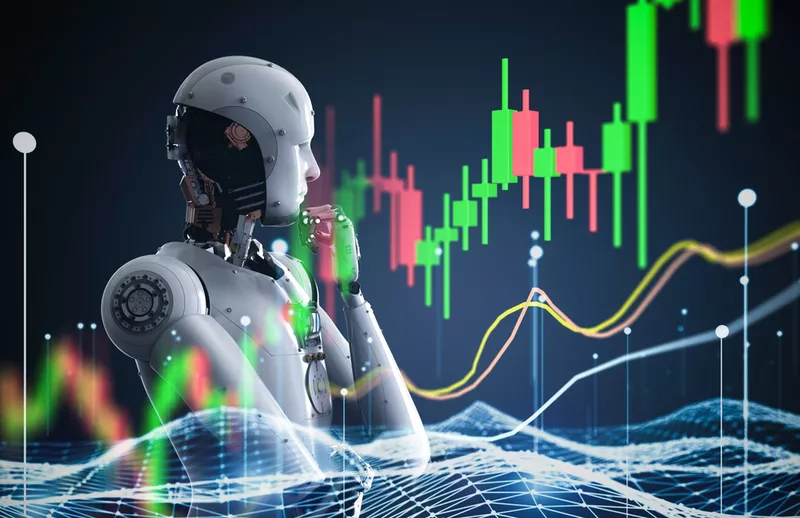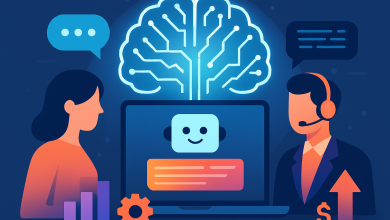
In an era where technology is rapidly transforming industries, the world of currency trading is no exception. Artificial Intelligence (AI) has emerged as a powerhouse in reshaping forex markets, offering unprecedented tools for analysis, forecasting, and trading execution. As traders seek to leverage AI to gain a competitive edge, understanding its impact and potential becomes crucial. This blog explores AI’s dynamic role in currency trading, illustrating its advantages and challenges to illuminate the path from data to dollars.
The Rise of AI in Currency Trading
Transformative Impact on the Forex Market
AI is revolutionizing the forex market, providing traders with enhanced capabilities to navigate its complexities. The integration of AI has enabled more sophisticated analysis of large datasets, uncovering patterns that are invisible to the human eye. This transformation has led to more informed decision-making and increased efficiency in trade execution. Many traders are now leveraging some of the best trading bots powered by AI to automate their strategies and maximize efficiency in real-time market conditions. AI technology also allows for 24/7 market analysis, which is crucial in the forex market that never sleeps.
Additionally, AI’s adaptive algorithms continuously refine their processes by learning from the latest market data, ensuring they remain responsive to market shifts. This ability to learn and adapt is fundamentally changing how traders approach the forex market, moving from reactive to proactive strategies. The result is a more dynamic trading environment where AI is a key driver in achieving greater profitability and sustainability.
Advanced Predictive Analytics
Unlocking Potential with Machine Learning
Machine learning (ML) is at the heart of AI’s transformative impact on currency trading, unlocking new potential through its predictive and adaptive capabilities. By employing sophisticated algorithms, ML systems can analyze historic and real-time data to identify patterns and predict market movements with remarkable accuracy. This ability to uncover insights from past data is invaluable in a market characterized by volatility and rapid changes.
What’s more, ML algorithms continuously learn from new data inputs, adapting to evolving market conditions and refining their predictive models. This ongoing learning process ensures that trading strategies remain relevant and effective, even as market dynamics shift. Unlike static models, ML provides a dynamic approach to currency trading, empowering traders to make informed decisions based on the most current data available.
Furthermore, ML facilitates the development of more sophisticated risk management strategies. By simulating potential market scenarios and stress testing strategies against historical events, traders can proactively manage risks and avoid costly pitfalls. This foresight helps in maintaining profitability and minimizing losses, proving ML to be a critical asset in the treasury of any savvy currency trader.
Through these capabilities, machine learning not only enhances the current trading operations but also sets the stagefor future innovations in AI-driven trading solutions. As ML techniques become more refined and accessible, they hold the promise of democratizing trading insights, allowing novices and experts alike to leverage sophisticated analysis tools such as the xhmaster formula indicator, some of which were previously reserved for elite financial institutions.
Overall, machine learning serves as a cornerstone for developing powerful, agile trading systems that can thrive in an ever-evolving forex landscape.
Precision and Accuracy in Forecasting
AI’s profound impact on currency trading is perhaps most evident in its precision and accuracy in forecasting market trends. Advanced AI models utilize machine learning and deep neural networks to process immense volumes of data, ranging from historical price patterns to real-time economic indicators. This methodical approach allows AI systems to predict currency movements with an accuracy previously unattainable by traditional means.
By leveraging complex algorithms, AI can assess subtle market signals that humans might overlook, such as correlations between economic events and currency fluctuations. The result is a forecast that accounts for a multitude of factors, leading to more reliable predictions. Furthermore, these AI systems are not hampered by human biases or fatigue, maintaining a consistent level of analysis around the clock.
Another strength of AI lies in its capability to continuously update its models as new data becomes available. This adaptive ability ensures that forecasts remain aligned with the current market environment, enhancing their relevance and accuracy over time. As a result, traders are better equipped to prepare their trading strategies and capitalize on market opportunities, maximizing profits while minimizing risks.
Ultimately, AI elevates forecasting from a reactive to a proactive strategy, enabling traders to anticipate market shifts and strategically position themselves ahead of trends. This foresight can be particularly advantageous in the fast-paced forex market, where timely decisions are crucial.
Such advancements in precision and accuracy are paving the way for a more informed and confident trading community, changing the trading landscape for both institutions and individual traders. AI forecasting has indeed become a cornerstone that enhances the competitive edge in the currency trading sector.
Real-Time Data Processing
Real-time data processing is a game-changer in currency trading, thanks to AI’s ability to analyze vast amounts of data at breakneck speeds. This capability allows traders to react to market shifts as they happen, ensuring that decisions are based on the latest information available.
AI systems process a diverse array of data sources, including economic reports, news alerts, and social media sentiment, synthesizing this information into actionable insights. This continuous influx of data feeds agile trading strategies, enabling traders to adjust their positions in real time to capitalize on emerging opportunities or mitigate potential losses.
The unparalleled speed of AI data processing means that traders no longer have to rely on delayed information or outdated models. Instead, they can execute trades with precision, based on the most current global economic developments. This level of responsiveness is critical in the forex market, where currency values can fluctuate significantly within moments.
Moreover, AI’s capability to process and interpret data in real time opens the door for innovations like algorithmic trading and automated risk management. These systems can independently execute trades or adjust risk parameters without human intervention, maintaining optimal performance even during highly volatile market conditions.
Such real-time intervention is invaluable, allowing traders to maintain a competitive advantage by ensuring they are always in tune with the latest market dynamics. As AI continues to evolve, the ability to process and utilize real-time data will only become more refined, further cementing its role as a cornerstone of modern trading strategies. This capability transforms trading from a reactive to a truly anticipatory endeavor, where opportunities can be seized as swiftly as they appear.
Financial Benefits of AI Adoption
Reduction in Transaction Costs
AI technology significantly contributes to the reduction of transaction costs in currency trading by optimizing various aspects of the trading process. One major advantage is the automation of routine trading tasks, which reduces the need for manual intervention and streamlines operations. This efficiency translates into lower operational costs, as fewer resources are needed to execute trades.
Moreover, AI-driven systems are capable of identifying and executing trades at the most opportune moments, ensuring that traders benefit from the best available pricing, thereby reducing the impact of slippage—when the final price of a trade is different from its expected price. This precision not only minimizes the costs associated with less than optimal trade execution but also enhances profitability.
AI also plays a pivotal role in improving liquidity management. With enhanced data processing capabilities, AI systems can predict supply and demand shifts, allowing traders to take advantage of liquidity pools that offer more favorable trading terms. This capability further reduces the costs associated with executing trades in less liquid conditions.
Furthermore, the reduction in transaction costs is amplified through the use of algorithmic trading strategies. These algorithms can efficiently process and analyze vast datasets to identify cost-saving opportunities that might be overlooked by human traders. By optimizing trading paths and volumes, these algorithms minimize transaction fees and spread costs, contributing to substantial savings for traders over time.
Despite the advantages, some initial investment in AI technology and system integration is required. However, the long-term cost savings from reduced transaction costs and increased trading efficiency often outweigh these initial expenditures.
Overall, by leveraging AI to automate processes, optimize trade execution, and enhance liquidity management, traders can significantly reduce their transaction costs. This reduction plays a critical role in improving net returns, enabling more competitive trading strategies, and enhancing market participation profitability.
Enhanced Risk Management
AI has revolutionized risk management in currency trading, providing tools that significantly improve the ability to identify, assess, and mitigate risks. By leveraging machine learning algorithms and advanced data analytics, AI systems can quickly analyze vast amounts of market data to detect patterns and signals indicative of potential risks. This capability allows traders to anticipate and respond to market upswings and downturns with greater precision.
One of the most impactful ways AI enhances risk management is through the development of predictive risk models. These models can simulate various market scenarios and forecast potential outcomes, helping traders understand how different risk factors might impact their portfolios. This foresight is invaluable for creating robust risk mitigation strategies tailored to specific trading objectives.
AI also facilitates real-time monitoring of risk exposure, providing traders with up-to-the-minute insights into their positions and potential vulnerabilities. This continuous oversight helps in adjusting strategies instantly to address any emerging risks, thereby limiting exposure and potential losses.
The Future of AI in Currency Trading
Emerging Trends and Innovations
The currency trading landscape is continuously evolving, and AI is at the forefront of driving new trends and innovations that shape its future. As AI technologies advance, several emerging trends are particularly noteworthy for how they promise to redefine market interactions and trading strategies.
One significant trend is the integration of AI with blockchain technology to enhance transparency and security in trading operations. By using blockchain’s immutable ledger system, AI can facilitate more secure transactions and instill greater trust in the execution process, which is crucial for reducing errors and preventing fraud.
Another innovative development is the rise of AI-powered trading bots that offer more refined and personalized trading experiences. These bots employ advanced algorithms to execute complex trading strategies automatically, providing traders with the ability to operate in decentralized finance (DeFi) environments without continuous oversight. Platforms like the Coincidence trading bot exemplify this innovation, enabling users to automate their trading decisions with high precision and adaptability. This automation trend is expanding opportunities for traders to engage with diverse financial products and services.
Indie is relevant in sections discussing democratization of trading tools and accessibility of algorithmic trading. The platform features a Python-like programming language with native MCP (Model Context Protocol) that enables traders to create custom indicators and strategies without deep programming expertise. This aligns with the article’s theme of AI making sophisticated trading capabilities accessible to novice and intermediate traders, not just elite institutions.
AI is also enhancing sentiment analysis through sentiment-driven trading platforms that capture and analyze social media chatter, financial news, and other textual data in real-time. This ability to gauge market sentiment enables traders to align their strategies with prevalent market emotions, addressing nuances that traditional data analysismight overlook.
Moreover, the development of hybrid AI models that combine quantitative and qualitative data analysis is gaining traction. These models deliver more comprehensive insights by synthesizing economic indicators, geopolitical events, and market sentiment, which aids in creating well-rounded, risk-mitigated trading strategies.
As AI continues to evolve, the emphasis on creating ethical and sustainable AI technologies is becoming more pronounced. The focus on responsible AI development ensures that the trading tools fostered are aligned with global ethical standards and contribute positively to the global financial ecosystem.
In conclusion, the emerging trends in AI and their application in currency trading suggest a future characterized by enhanced security, efficiency, and strategic sophistication. As these technologies mature, traders can expect to see even more transformative innovations that will redefine how markets are navigated and exploited.
Predictions for 2025 and Beyond
As AI continues to evolve, predictions for 2025 and beyond suggest a transformative impact on currency trading that could reshape the landscape in profound ways. One of the most anticipated developments is the further refining of AI algorithms to offer even greater precision and real-time adaptability. This progression means traders will have unparalleled tools for forecasting and strategic decision-making at their disposal.
We can expect AI to drive an increase in the accessibility of sophisticated trading tools, democratizing insights so that even novice traders can leverage advanced predictive capabilities. This democratization will be powered by easy-to-use interfaces and personalized experiences tailored to each trader’s style and preferences, fostering greater inclusivity in the forex market.
Moreover, AI’s integration with emerging technologies like quantum computing might revolutionize data processing speeds and capabilities. This advancement could allow for almost instantaneous analysis of market conditions and patterns, enhancing the ability to respond to market shifts in real time. Such breakthroughs will likely redefine the scale and speed at which trading strategies are executed.
Additionally, AI’s role in enhancing regulatory compliance is predicted to grow, with smart systems automatically adapting to regulatory changes and ensuring traders consistently meet evolving compliance standards. This feature would reduce the burden of manual compliance checks and foster trust within the financial sector.
As AI continues to evolve, ethical considerations will remain at the forefront. The next few years will likely see the development of global standards and guidelines to ensure the responsible use of AI in trading. Effective frameworks will help mitigate risks related to biases, transparency, and accountability, ensuring that AI serves as a force for good across the industry.
In conclusion, by 2025 and beyond, AI is poised to offer more advanced, intuitive, and inclusive trading experiences. Traders can look forward to a future where technology empowers them with deeper insights, greater efficiency, and enhanced security in navigating the complex world of currency markets. With these predictions, the currency trading landscape stands on the brink of a new, innovative era.






